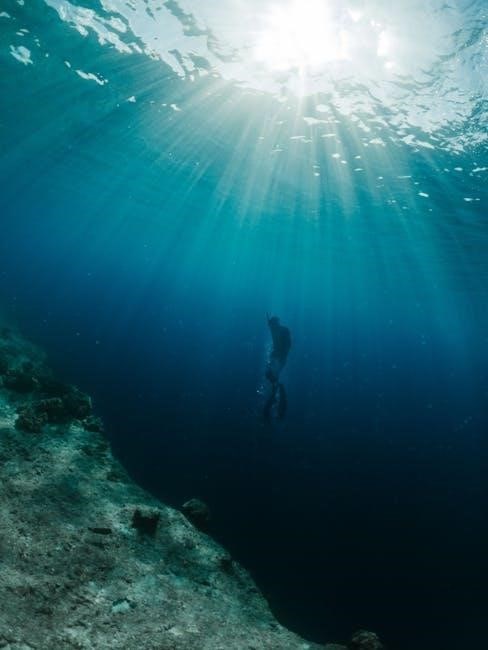scuba diving wetsuit thickness guide
Wetsuit thickness is crucial for thermal protection and comfort during scuba diving․ It depends on water temperature, dive depth, and personal preferences, with common thicknesses ranging from 3mm to 7mm․
1․1 Importance of Wetsuit Thickness in Scuba Diving
Wetsuit thickness is vital for maintaining body heat, comfort, and safety during scuba diving․ It acts as thermal insulation, preventing heat loss in cold water and protecting against hypothermia․ Proper thickness ensures adequate warmth without compromising mobility, allowing divers to focus on their underwater experience․ Thinner suits are ideal for warm waters, while thicker ones are essential for colder conditions․ The right thickness also prevents excessive buoyancy and restricts water flow, enhancing diving efficiency․ Choosing the wrong thickness can lead to discomfort, reduced performance, or even safety risks, making it a critical factor in dive preparation and enjoyment․
1․2 Overview of Wetsuit Materials and Construction
Wetsuits are primarily made from neoprene, a flexible rubber material that provides insulation and protection․ The construction involves gluing and stitching neoprene panels together to form a full or partial suit․ Seam construction varies, with flatlock stitching offering flexibility and blind-stitched seams providing durability․ Wetsuits often feature lining materials for added warmth and protection․ The thickness of the neoprene determines the suit’s insulating properties, with thicker materials used in colder conditions․ High-quality wetsuits may include reinforced areas for durability and sealed seams to prevent water entry․ Proper construction ensures a snug fit, minimizing water flow and maximizing warmth and mobility during dives․
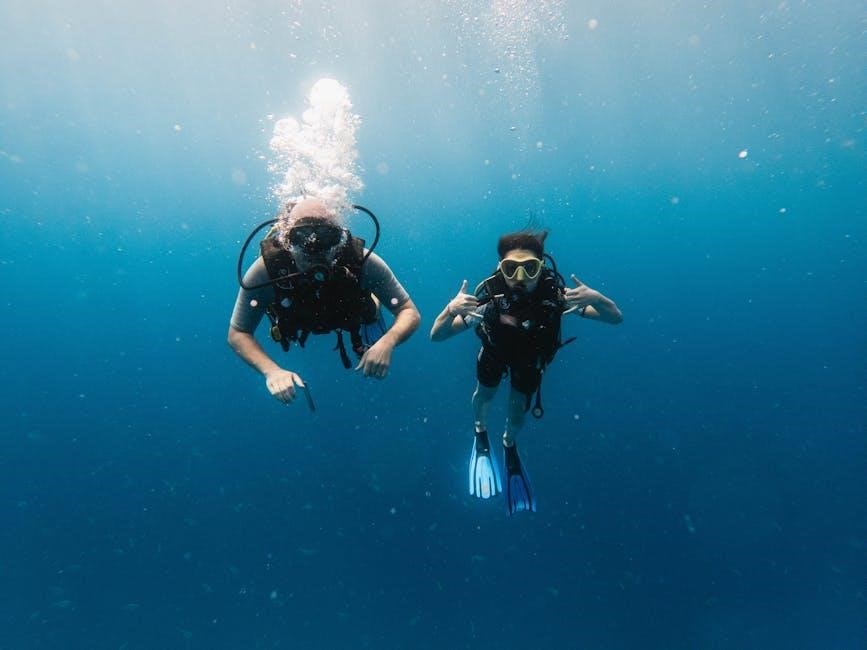
Factors Influencing Wetsuit Thickness
Water temperature, dive depth, duration, and personal comfort are key factors influencing wetsuit thickness, ensuring optimal warmth and mobility during scuba diving․
2․1 Water Temperature and Its Impact on Wetsuit Choice
Water temperature is the primary factor influencing wetsuit thickness․ Warmer waters (above 82․4°F/28°C) require minimal protection, such as a rash guard or dive skin․ As temperatures drop, thicker wetsuits are necessary to maintain body heat․ For example, tropical diving may use a 3mm suit, while temperate waters (50°F-77°F/10°C-25°C) often require 5mm or 7mm suits․ The colder the water, the thicker the neoprene needed to prevent hypothermia․ This guide helps divers choose the right thickness for their environment, ensuring comfort and safety underwater․ Proper fit and material quality also play roles, but temperature remains the most critical determinant of wetsuit thickness․
2․2 Dive Depth and Duration
Dive depth and duration significantly influence wetsuit thickness․ Greater depths expose divers to higher water pressure, which compresses neoprene, reducing its insulating properties․ Thicker wetsuits (5mm-7mm) are recommended for deep dives to maintain warmth․ Similarly, longer dives require more insulation to prevent heat loss over time․ A 3mm wetsuit might suffice for shallow, short dives in warm water, but deeper or extended dives demand thicker neoprene to ensure thermal protection and comfort․ Balancing depth, duration, and water temperature is essential for selecting the appropriate wetsuit thickness, ensuring both safety and comfort during underwater exploration․
2․3 Personal Comfort and Preferences
Personal comfort and preferences play a vital role in choosing wetsuit thickness․ Some divers prioritize warmth and opt for thicker suits, while others prefer mobility and select thinner options․ Body composition, metabolism, and sensitivity to cold also influence decisions․ For example, a diver who feels the cold more may choose a 5mm suit over a 3mm for the same conditions․ Additionally, the fit and flexibility of the wetsuit affect comfort underwater․ Ultimately, the right thickness balances thermal protection with ease of movement, ensuring an enjoyable diving experience tailored to individual needs and preferences, regardless of external factors like water temperature or depth․
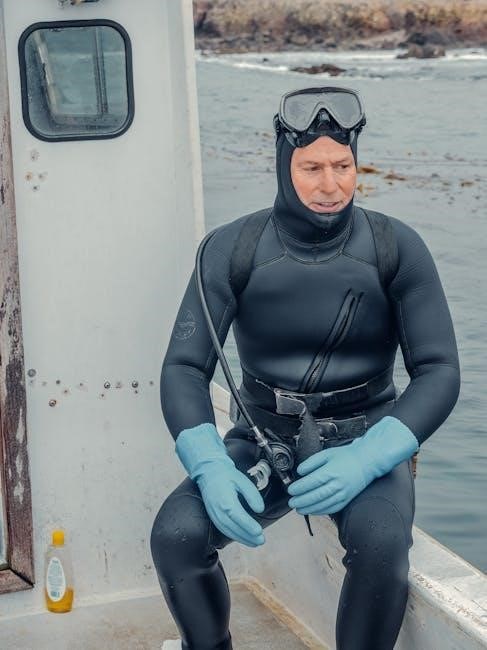
Common Wetsuit Thickness Recommendations
Wetsuit thickness recommendations vary based on water temperature and diving conditions․ Common choices include 3mm for warm waters, 5mm for temperate, and 7mm for cold conditions․
3․1 Tropical Waters (Above 82․4°F / 28°C)
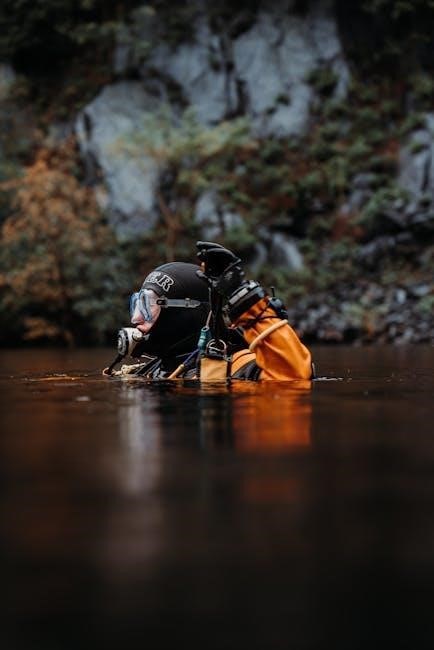
In tropical waters exceeding 82․4°F (28°C), minimal thermal protection is needed․ A 1-2mm wetsuit or shorty is sufficient, but many divers opt for rashguards or dive skins for UV protection․ These lightweight options provide comfort and flexibility, reducing heat buildup․ For extended dives, a 1mm full suit may be considered for added protection without sacrificing mobility․ Tropical conditions prioritize comfort and sun protection over warmth, making thinner suits ideal․ Divers in destinations like Bali, Hawaii, or the Maldives often prefer these lighter options to stay cool and agile underwater․
3․2 Warm Waters (77°F ‒ 80․6°F / 25°C ‒ 27°C)
In warm waters between 77°F and 80․6°F (25°C ー 27°C), a 2-3mm wetsuit is ideal for scuba diving․ This thickness provides adequate warmth without sacrificing mobility․ A 2mm shorty wetsuit or a 1mm full suit is also suitable, offering light protection while keeping you comfortable in warmer conditions․ These suits are perfect for destinations like the Red Sea, the Caribbean, or Southeast Asia during their warmer seasons․ The balance between thermal protection and flexibility ensures an enjoyable diving experience in these temperatures, making 2-3mm wetsuits a popular choice for many divers exploring coral reefs and tropical marine life․
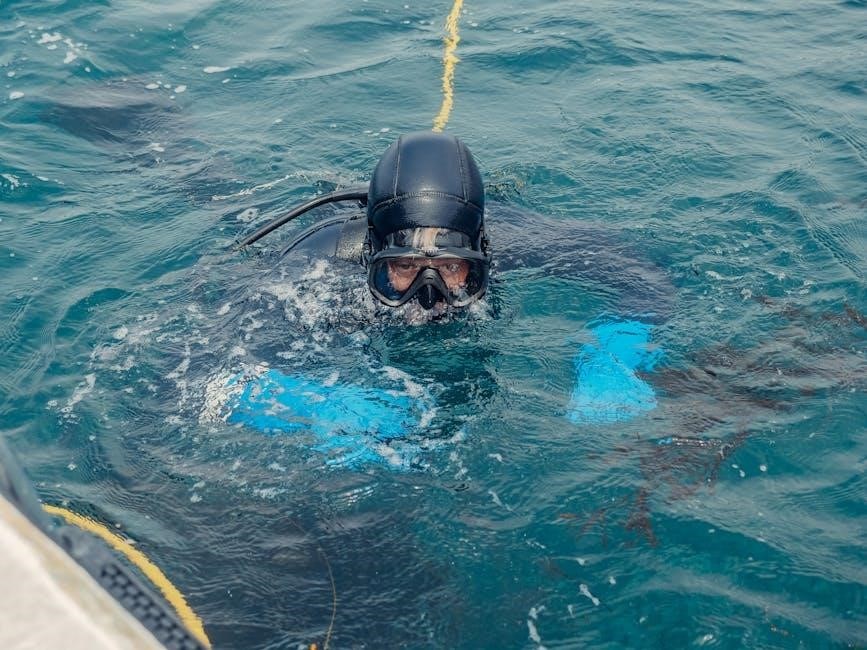
3․3 Moderate Waters (71․6°F ‒ 75․2°F / 22°C ‒ 24°C)
For moderate waters between 71․6°F and 75․2°F (22°C ー 24°C), a 3mm full wetsuit is recommended․ This thickness offers excellent thermal insulation while maintaining flexibility․ It is suitable for regions like the Mediterranean during summer or parts of Australia․ The 3mm neoprene provides sufficient warmth for longer dives without causing discomfort․ Additionally, it protects against wind and sun exposure on the surface․ This thickness is a versatile choice for divers seeking a balance between warmth and mobility in temperate waters, ensuring a comfortable experience throughout the dive․
3․4 Cool Waters (62․6°F ‒ 69․8°F / 17°C ー 21°C)
In cool waters between 62․6°F and 69․8°F (17°C ‒ 21°C), a 4-5mm full wetsuit is ideal for optimal warmth and protection․ This thickness provides excellent thermal insulation, reducing heat loss and preventing hypothermia during extended dives․ The 4-5mm neoprene is thick enough to withstand cooler conditions but still flexible for ease of movement․ It’s perfect for regions like the North Sea, coastal areas of Northern Europe, or the U․S․ Pacific Coast․ The full suit ensures complete coverage, protecting against wind and surface chill․ This thickness strikes a balance between warmth and mobility, making it a popular choice for divers in temperate climates․
3․5 Cold Waters (50°F ー 65°F / 10°C ‒ 17°C)
For diving in cold waters between 50°F and 65°F (10°C ‒ 17°C), a 5-7mm full wetsuit is essential for thermal protection․ This thickness provides excellent insulation, minimizing heat loss and preventing hypothermia․ The 5-7mm neoprene is ideal for maintaining body warmth in cooler conditions while still allowing flexibility for movement․ Divers in regions like the North Atlantic, Mediterranean winter months, or colder parts of the Pacific Coast often opt for this range․ Some divers prefer layered wetsuits (e․g․, 5/4/3 mm) for added warmth․ This thickness ensures comfort and safety during extended dives in cold water environments․
3․6 Extremely Cold Waters (Below 50°F / 10°C)
In extremely cold waters below 50°F (10°C), a wetsuit thickness of 7mm or more is essential for thermal protection․ These conditions require maximum insulation to prevent hypothermia․ A 7mm full suit is commonly recommended, while some divers opt for 9mm suits in severe cold․ Layered wetsuits, such as 7/5/3 mm, are also popular for added warmth․ At these temperatures, even a well-fitted thick wetsuit may not be sufficient for extended dives, making a dry suit a more practical choice․ The priority is to maintain body heat and ensure safety in freezing water conditions, where every degree of warmth matters for comfort and survival․
Wetsuit Thickness by Activity
Wetsuit thickness varies by activity: scuba diving uses 5mm for warmth, freediving opts for 3mm mobility, and surfing prefers 4mm for flexibility, tailored to specific needs and conditions․
4․1 Scuba Diving
Scuba diving requires wetsuits tailored to water temperature and dive conditions․ Thinner suits (3mm) are ideal for warm, tropical waters, while thicker suits (5mm or 7mm) provide insulation in colder environments․ The choice balances warmth, mobility, and buoyancy needs․ For example, a 5mm suit is common in temperate waters, offering flexibility and thermal protection without hindering movement․ In colder conditions, a 7mm suit is preferred for extended dives․ Activity-specific features like reinforced knees and seamless construction enhance durability and comfort․ Proper fit ensures safety and performance, making thickness selection critical for a successful dive experience․
4․2 Freediving
Freediving typically requires thinner wetsuits compared to scuba diving, emphasizing flexibility and minimal buoyancy․ A 1․5mm to 3mm thickness is common, allowing unrestricted movement during deep dives․ Thinner suits reduce weight and drag, crucial for conserving energy․ However, in colder waters, freedivers may opt for thicker suits up to 5mm for thermal protection without sacrificing mobility․ The choice also depends on the diver’s comfort and the duration of the dive․ Proper fit ensures optimal performance and comfort, making thickness selection vital for freediving success․
4;3 Surfing and Other Water Sports
Surfing and water sports often require wetsuits with specific thicknesses for optimal performance․ Thinner suits, typically 2mm to 3mm, are preferred for warmer waters, offering flexibility and ease of movement․ In cooler conditions, 3mm to 4mm suits provide adequate warmth while maintaining mobility․ For colder climates, 4mm to 5mm suits are ideal, balancing warmth and flexibility․ The choice also depends on the activity’s intensity and duration, as thicker suits may hinder movement․ Proper fit and thickness ensure comfort and performance, making them essential for surfing and other water sports․
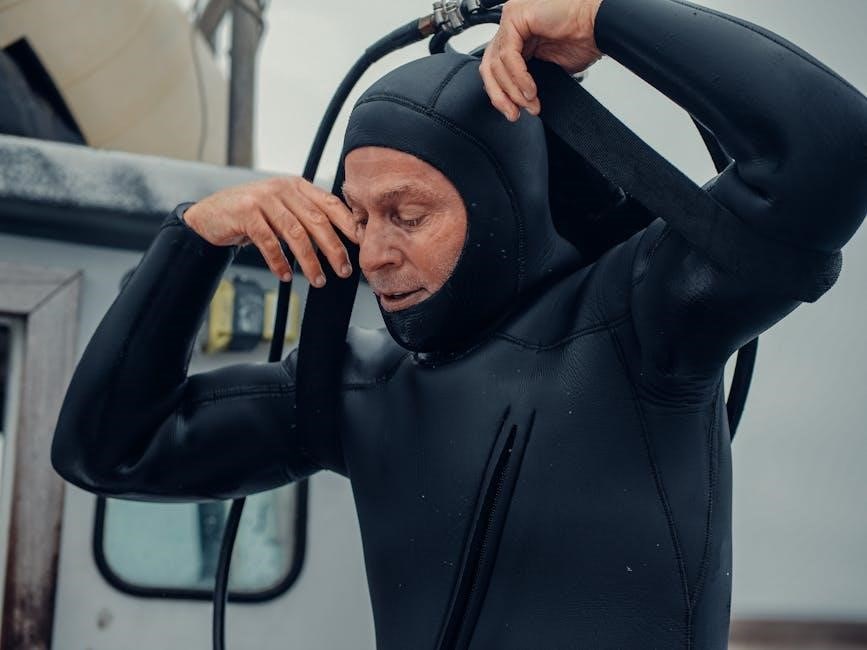
Specialized Wetsuit Thickness Options
Specialized wetsuits offer tailored solutions for diverse diving needs, including full suits, shorties, layered options like 5/4/3 mm, and custom fits for enhanced comfort and performance․
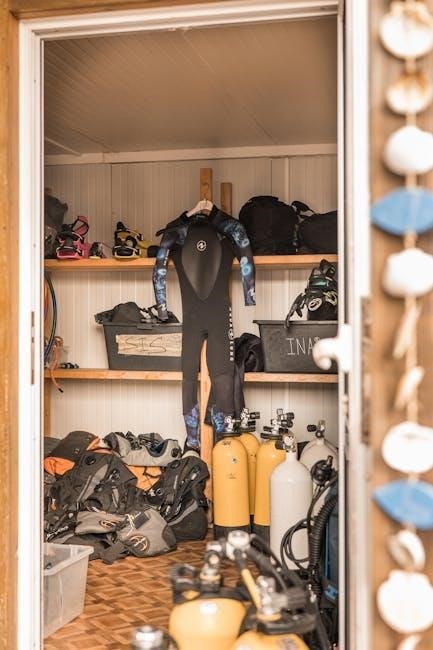
5․1 Full Suits vs․ Shorties
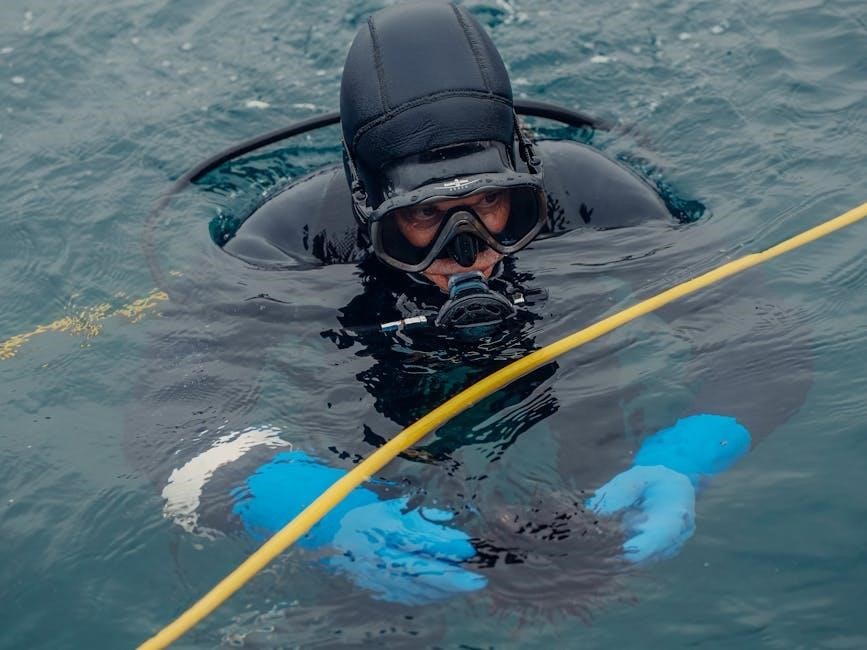
Choosing between full suits and shorties depends on water temperature and personal preference․ Full suits provide maximum coverage and warmth, ideal for cooler waters, while shorties offer flexibility and are better suited for warmer conditions․ Full suits cover the torso, arms, and legs, making them perfect for colder dives, whereas shorties expose the arms and legs, reducing bulk and improving mobility․ For tropical waters, shorties are often preferred, but in temperate or cold conditions, full suits are essential for thermal protection․ Both options are available in varying thicknesses, allowing divers to balance warmth and mobility effectively․
5․2 Layered Wetsuits (e․g․, 5/4/3 mm)
Layered wetsuits, such as 5/4/3 mm, offer varying thicknesses across different body parts for optimal warmth and flexibility․ The torso typically has the thickest neoprene (e․g․, 5 mm) to protect the core, while the arms and legs are thinner (e․g․, 3 mm) for better mobility․ This design balances thermal insulation with ease of movement, making it ideal for cold-water diving․ The layered construction ensures that critical areas remain warm without sacrificing flexibility․ This feature is particularly beneficial for divers in cooler climates or those engaging in extended dives, where maintaining body heat is essential․
5․3 Custom Fit and Tailored Thickness
A custom-fit wetsuit ensures optimal performance by catering to individual body shapes and diving needs․ Tailored thickness options allow divers to prioritize warmth in specific areas, such as the core, while maintaining flexibility in joints․ This personalized approach enhances comfort and mobility, reducing water entry and improving thermal retention․ Custom wetsuits are particularly beneficial for divers with unique body types or those engaging in specialized activities․ By combining tailored fit with strategic thickness distribution, divers can achieve the perfect balance of warmth, flexibility, and performance for their specific diving conditions․
How to Choose the Right Wetsuit Thickness
Choosing the right wetsuit thickness involves assessing water temperature, dive depth, and personal comfort․ Proper selection ensures warmth, mobility, and an enjoyable diving experience․
6․1 Assessing Your Dive Location
Assessing your dive location is the first step in selecting the right wetsuit thickness․ Different regions have varying water temperatures, which directly influence your choice․ For instance, tropical locations like Bali or Hawaii typically require thinner suits, while colder areas such as the British Isles demand thicker neoprene․ Understanding the average water temperature of your destination helps narrow down the appropriate wetsuit thickness․ Additionally, considering the time of year and seasonal variations ensures you’re prepared for the conditions you’ll encounter․ This initial assessment sets the foundation for a comfortable and safe diving experience, tailored to your specific environment․
6․2 Considering Dive Depth and Duration
When choosing a wetsuit, dive depth and duration play a significant role․ Deeper dives expose you to colder water, increasing heat loss․ Thicker wetsuits, such as 5mm or 7mm, are recommended for deeper dives to maintain warmth․ Similarly, extended dive durations require greater insulation to prevent hypothermia․ For example, a 3mm wetsuit might suffice for shallow, short dives in warm waters, but a 7mm suit is better for prolonged dives in cooler conditions․ Technical divers exploring deep or cold waters often opt for 5-7mm wetsuits or even dry suits for extreme cases․ Balancing thickness with mobility ensures comfort and safety during extended underwater explorations․
6․3 Balancing Warmth and Mobility
Balancing warmth and mobility is essential when selecting a wetsuit thickness․ Thicker suits provide greater insulation but may restrict movement, while thinner suits offer flexibility but less warmth․ For most divers, a 3mm to 5mm wetsuit strikes a practical balance, offering warmth without hindering mobility․ In colder waters, a 5mm or 7mm wetsuit is ideal for extended dives, as the added thickness prevents heat loss․ However, high-quality neoprene can maintain flexibility even in thicker suits․ Ultimately, the choice depends on the specific diving conditions and personal comfort preferences, ensuring optimal performance and safety underwater;
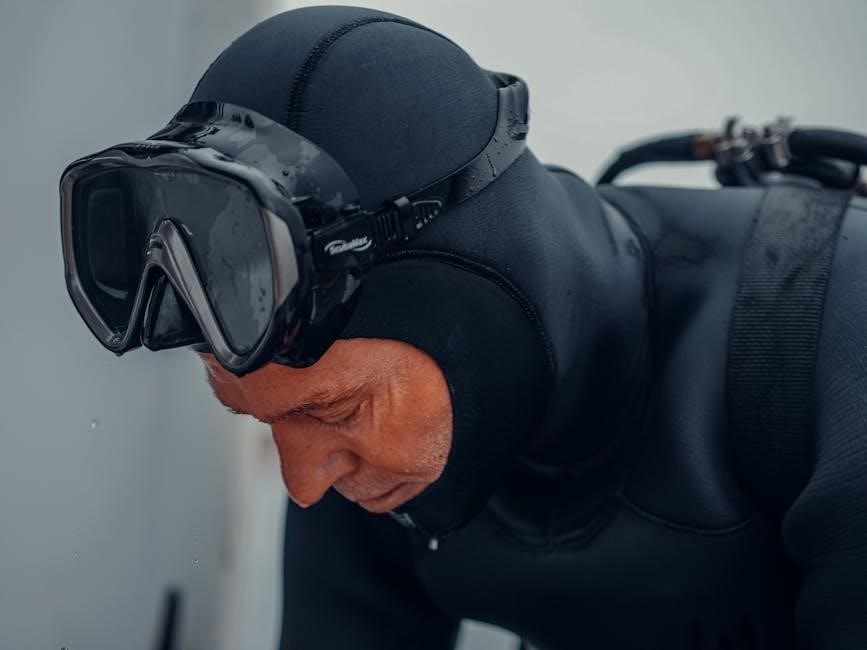
Maintenance and Care of Wetsuits
Regular cleaning with fresh water, mild detergent, and avoiding direct sunlight helps preserve neoprene․ Store on a hanger to maintain shape and prevent creasing or damage․
7․1 Cleaning and Storing Your Wetsuit
Proper cleaning and storage are essential for maintaining your wetsuit’s performance and longevity․ After each use, rinse the suit thoroughly with fresh water to remove salt, sand, and bacteria․ Use a mild detergent specifically designed for neoprene to clean both the inside and outside․ Avoid harsh chemicals or abrasive materials that can damage the material․ Allow the wetsuit to air dry in a shaded area, as direct sunlight can cause fading or cracking․ Store it on a sturdy hanger to maintain its shape, ensuring it doesn’t fold or crease․ Regular maintenance prevents odors and extends the life of your wetsuit․
7․2 Avoiding Damage to Neoprene
To maintain your wetsuit’s integrity, handle it with care to avoid damaging the neoprene․ Avoid sharp objects, nails, or jewelry that could puncture or tear the material․ Never stretch or fold the wetsuit excessively, as this can weaken the neoprene․ When putting it on or taking it off, use a lubricant like water or wetsuit lube to reduce friction․ Avoid exposing the suit to direct sunlight for extended periods, as UV rays can cause fading and cracking․ Store it on a sturdy hanger to prevent creasing․ Regularly inspect for signs of wear and repair minor tears promptly to prevent further damage․ Proper care ensures your wetsuit remains durable and performs well for years․
When to Consider a Dry Suit Instead
Dry suits are ideal for extreme cold water, extended dives, or personal preference, offering superior warmth and protection compared to wetsuits in harsh conditions․
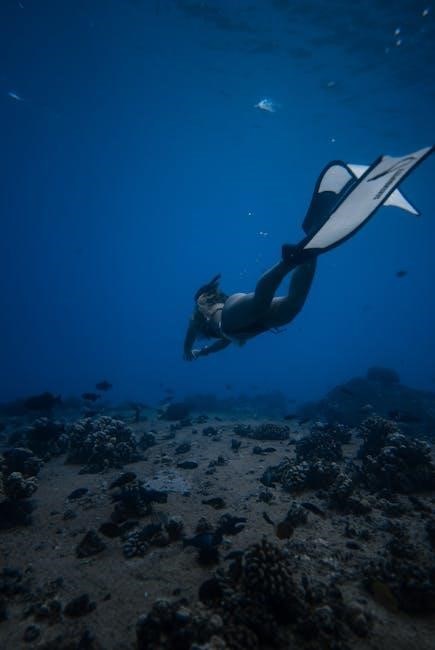
8․1 Extreme Cold Water Conditions
In extreme cold water conditions, typically below 50°F (10°C), a dry suit becomes essential․ Wetsuits, even at maximum thickness (7mm), may not provide adequate insulation in such environments․ Dry suits prevent water from contacting the skin, offering superior thermal protection and reducing the risk of hypothermia․ They are particularly recommended for dives in icy or near-freezing temperatures, where wetsuits would be insufficient․ Dry suits also allow for layered undergarments, further enhancing warmth․ For prolonged exposure in cold water, a dry suit is the safest and most practical choice, ensuring diver comfort and safety during extended dives in harsh conditions․
8․2 Extended Dive Duration in Cold Waters
Extended dive duration in cold waters amplifies the need for optimal thermal protection․ Prolonged exposure to cold water increases heat loss, making thick wetsuits insufficient․ Even 7mm wetsuits may fail to maintain core warmth during long dives, risking hypothermia․ Dry suits are preferable as they prevent water from contacting the skin, reducing heat loss significantly․ Layered undergarments with dry suits enhance insulation, ensuring comfort and safety․ For dives lasting several hours in cold conditions, dry suits are essential to maintain body heat and prevent fatigue․ They are a critical choice for extended cold-water diving, offering unparalleled protection and comfort compared to traditional wetsuits․
8․3 Personal Preference for Dry Suits
Personal preference plays a significant role in choosing dry suits over wetsuits․ Some divers prioritize the absolute dryness and comfort dry suits provide, regardless of water temperature․ Others prefer the freedom of movement and reduced risk of chafing that dry suits can offer․ Many divers also appreciate the ability to customize thermal protection with layered undergarments, tailored to their specific needs․ Additionally, personal tolerance for cold and individual comfort in neoprene can influence this choice․ Dry suits cater to those who value these benefits, even if wetsuits might technically suffice for certain conditions․ Ultimately, personal preference often dictates the decision to opt for a dry suit․

